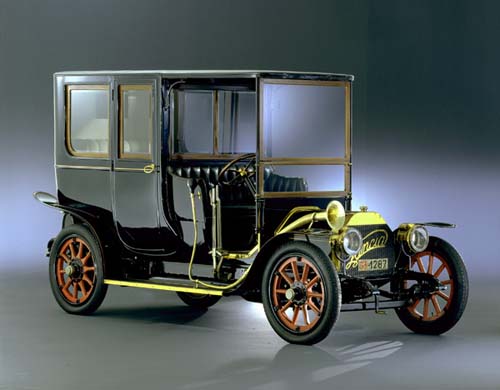|
Lancia Tipo 51
Work on the first car started immediately after the establishment of Lancia in 1906. A fire that broke out in the factory
delayed the project. The first prototype was ready by September 1907. The new car was known internally as Tipo 51. The official
name was 18-24 hp, hp being the rated power and 24 the actual power.
The Tipo 51 had a 2543 cc four-cylinder engine. The car was first revealed at the Turin Salon 1908. The engine ran up till
1500 rpm; which was substantially high when the other engines never touched 1000! Further development of the engine saw that
actual power reaching 28 hp at 1800 rpm. The production of the Alpha stopped in the summer of 1909. A total of 108 units were
made during its production run.
It was in 1919 that Lancia started using the Greek alphabets for the names of his cars. The Tipo 51 was retrospectively renamed
as Alpha.
Lancia Dialpha
The Dialpha was introduced in the summer of 1908. This had a six-cylinder engine derived from the engine of the Alpha by adding
two cylinders more. This was one among the first six-cylinder cars to be produced. The Dialpha was longer than the Alpha and
could touch 110 km/hr making it one among the fastest on the roads. However, only twenty-three units were made.
Lancia Beta
The Lancia Beta is in a sense a heavily revised Lancia Alpha. The new car had a monobloc (as against the bibloc construction
of Alpha) 3,119 cc four-cylinder engine. It developed 34 hp at 1,500 rpm. The production started in 1909 and ended by the
next year. A total of 150 cars were produced.
Lancia Gamma
The Lancia Gamma (1910) again was an evolutionary development over the Beta. With an increase in bore the engine capacity
increased to 3,456 cc with a maximum power output of 40 bhp. Although the standard chassis was the same as the Beta, short
wheelbase and long wheelbase could be specified. The short wheel base cars with a longer stroke 4,712 cc engine were frequently
used in different competitions. The car was available both as a chassis and with a factory fitted body.
Birth of the Logo
Lancia adopted a new logo designed by Count Biscarettu Di Ruffia in 1911. Prior to this Lancia carried a simple ‘Lancia
& C.’ plate.
Lancia Delta
The Lancia Delta was introduced as a successor to the Lancia Gamma. It came with a 60 bhp 4,712 cc engine, although it was
rated at 20 hp. The chassis was a carry-over. A higher performance version was available called the Lancia Bidelta.
Lancia Epsilon
The Lancia Epsilon was released in the same year as the Delta. It was basically a long wheel base Delta. The wheelbase of
the Delta was longer by 295 mm.
Lancia Eta
The Lancia introduced in 1911 was the short wheelbase version of the Lancia Eta. Its wheelbase was 157 mm shorter than the
Delta. It also came with dynamo and lighting.
Lancia Zeta
The Lancia Zeta, introduced in 1912, was also known as the vetturette in Italy. It was powered by a 2614 cc rated at 15 hp.
In practise it had around 30 bhp at 1,800 rpm. The engine was very short due to innovative mounting of the crankshaft. It
had a four-speed gearbox. Though innovative and fresh, the Zeta was a sales disaster with 34 units only.
Lancia Theta (1913 – 1919)
The failure of the Lancia Zeta was compensated to a certain extent by the Lancia Theta launched in 1913. It had a similar
chassis to the Delta. It boasted a complete range of built-in electrical equipment for the first time in Europe including
dynamo and full lighting, electric starter and horn. Lancia introduced a rake adjustable steering wheel with three adjustable
positions on the Lancia Theta. The engine had 4942 cc with actual power of 70 bhp. It also followed the trend of offering
different wheelbases for the same model by offering both short wheelbase and long wheelbase versions. In total 1,696 units
was built and it was successful even in Britain and United States.

Lancia Alpha: Further details are not known
Lancia was also developing V8 engines, which were still unusual at that time. The design was patented just before war. All
work stopped in 1915 though.
(This article is not in its final format.)
|

